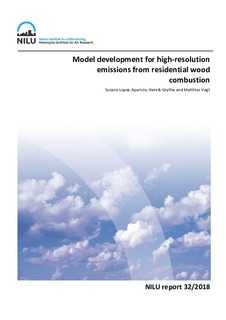| dc.contributor.author | Lopez-Aparicio, Susana | |
| dc.contributor.author | Grythe, Henrik | |
| dc.contributor.author | Vogt, Matthias | |
| dc.date.accessioned | 2019-02-06T14:19:13Z | |
| dc.date.available | 2019-02-06T14:19:13Z | |
| dc.date.created | 2019-02-05T13:48:52Z | |
| dc.date.issued | 2018 | |
| dc.identifier.isbn | 978-82-425-2955-8 | |
| dc.identifier.issn | 2464-3327 | |
| dc.identifier.uri | http://hdl.handle.net/11250/2584182 | |
| dc.description.abstract | In this report, we describe the MetVed model developed to estimate emissions from residential wood combustion (RWC) at high spatial-temporal resolution. The model uses a downscaling method approach, which builds on bottom-up principles and derive a wood burning potential for each grid based on the housing type, size and heating technology, energy demand and outdoor temperature of each grid. The model builds on the combination of several databases with information at high level of detail. The databases contain geo-localised information about dwelling number and type, energy consumption statistics, fireplace and stove locations, and the available technology for residential heating. The datasets are combined and the dependencies between the different variables are analysed. MetVed includes the time variation for RWC based on the heating degree concept combined with time-variation from consumer statistics, and the vertical distribution based on the RWC shared in apartment buildings versus houses. The results from the MetVed-model have shown to improve the accuracy of dispersion modelling results when compared with predictions based on previous emission inventories. | en |
| dc.description.abstract | I denne rapporten beskriver vi MetVed-modellen. Denne modellen estimerer vedfyringsutslipp med høy oppløsning. Metved-modellen kombinerer nedskalering med bottom-up prinsipper for å estimere vedfyringspotensiale i modellgrid. Den baserer seg på boligtyper, størrelse, oppvarmingsteknologi, energibehov og utendørs temperatur. Modellen baserer seg på å kombinere flere databaser med høyt detaljert informasjon. Databasene inneholder boligtall og boligtyper med 250 meters romlig oppløsning, statistikk av energibruk i husholdninger, plassering av ildsteder som punktkilder, og geografisk posisjon av boliger med informasjon om boligtyper og tilgjengelige teknologier for oppvarming i husholdningene. Databasene blir i MetVed-modellen kombinert og forhold mellom ulike variabler analysert. MetVed-modellen inkluderer en tidsvarisjon av vedforbruket som baserer seg på oppvarmingsgradkonseptet kombinert med tidsvariasjon fra forbrukerstatistikk. Vertikalfordeling av utslippene baserer seg på vedforbruk fordelt på leiligheter og hus (enebolig, tomannsbolig og rekkehus). Resultater fra spredningsmodellberegninger viser at utslippsdata fra MetVed-modellen gir bedre samsvar med målinger enn spredningsberegninger basert på utslipp fra tidligere metoder for å estimere vedfyringsutslipp. | nb_NO |
| dc.language.iso | eng | nb_NO |
| dc.publisher | NILU | nb_NO |
| dc.relation.ispartof | NILU rapport | |
| dc.relation.ispartofseries | NILU report;32/2018 | |
| dc.relation.ispartofseries | Norwegian Environment Agency;M-1261|2019 | |
| dc.subject | Luftkvalitet | nb_NO |
| dc.subject | Air quality | nb_NO |
| dc.subject | Utslippskontroll | nb_NO |
| dc.subject | Effluent control | nb_NO |
| dc.title | Model development for high-resolution emissions from residential wood combustion | en |
| dc.title.alternative | Utvikling av modell for høyoppløselig utslipp fra vedfyring | nb_NO |
| dc.type | Research report | nb_NO |
| dc.description.version | publishedVersion | nb_NO |
| dc.rights.holder | © NILU – Norwegian Institute for Air Research | nb_NO |
| dc.source.pagenumber | 31 | nb_NO |
| dc.source.issue | 32/2018 | nb_NO |
| dc.identifier.cristin | 1673646 | |
| dc.relation.project | NILU - Norsk institutt for luftforskning: 117104 | nb_NO |
| dc.relation.project | Miljødirektoratet: MetVed | nb_NO |
| cristin.unitcode | 7460,54,0,0 | |
| cristin.unitname | By og industri | |
| cristin.ispublished | true | |
| cristin.fulltext | original | |
